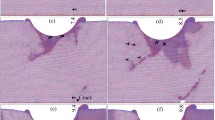Abstract
The maximum work principle of Bishop-Hill was developed to analyze the axisymmetric co-deformation in face-centered cubic crystals (f.c.c.) for twinning on {111}〈112〉 and slip on {111}〈110〉 systems. The influence of ξ, the ratio of critical resolved shear stress for twinning to slip, on the yield stress states and corresponding active slip or/and twinning systems for orientations in the standard stereographic triangle of cubic crystal was investigated systematically. The Taylor factors and the anisotropy of yield strength for three important orientations [100], [110] and [111] in orientation space were analyzed. It is found that the yield strength asymmetry for the case of axisymmetric deformation of tension and compression can be explained based on the microscopic theory of crystal plasticity. The concept of orientation factor for twinning ability was proposed and the deformation mechanism map in the orientation space was established for the case of axisymmetric deformation. The deformation texture formation and development of f.c.c. crystals with low stacking fault energy for axisymmetric tension can be explained qualitatively on the basis of analyzed results.
Similar content being viewed by others
References
Kalidindi S R. A crystal plasticity framework for deformation twinning. In: Raabe D, Roters F, Barlat F, et al. eds. Continuum Scale Simulation of Engineering of Materials. New York: Wiley-VCH, 2004. 543–560
Ahlborn H. Orientierungsänderungen von einkristallen kubisch flächenzentrierter metalle beim ziehvorgang. Z Metallkd, 1965, 56: 205–215
Chin G Y, Mendorf D R, Hosford W F. Accommodation of constrained deformation in f.c.c. metals by slip and twinning. Proc Roy Soc A, 1969, 309: 433–456
Hirsch J, Lücke K. Mechanism of deformation and development of rolling textures in polycrystalline fcc metals. I. Description of rolling texture development in homogeneous CuZn alloys. Acta Metall, 1988, 36: 2863–2882
Hirsch J, Lücke K, Hatherly M. Mechanism of deformation and development of rolling textures in polycrystalline fcc metals. III. The influence of slip inhomogeneities and twinning. Acta Metall, 1988, 36: 2905–2927
El-Danaf E, Kalidindi S R, Doherty R D. Influence of grain size and stacking-fault energy on deformation twinning in fcc metals. Metall Mater Trans A, 1999, 30A: 1223–1233
El-Danaf E, Kalidindi S R, Doherty R D. Influence of deformation path on the strain hardening behavior and microstructure evolution in low SFE FCC metals. Int J of Plasticity, 2001, 17: 1245–1265
Szczerba M S, Bajor T, Tokarski T. Is there a critical resolved shear stress for twinning in face-centred cubic crystals. Phil Mag, 2004, 84: 481–502
Ahlborn H, Wassermann G. Einfluß von verformungsgrad und-temperatur auf die textur von silberdrähten. Z Metallkd, 1963, 54: 1–6
English A T, Chin G Y. On the variation of wire texture with stacking fault energy in f.c.c. metals and alloys. Acta Metall, 1965, 13: 1013–1016
Chen Z Y, Zhang X M, Liu C M, et al. Co-yield surfaces for {111} 〈110〉 slip and {111}〈112〉 twinning in fcc metals, J Mater Sci, 2002, 37: 2843–2848
Bishop J F W, Hill R. A theory of the plastic distortion of a polycrystalline aggregate under combined stresses. Phil Mag, 1951, 42: 414–427
Bishop J F W, Hill R. A theory of derivation of the plastic properties of a polycrystalline face-centered metals. Phil Mag, 1951, 42: 1298–1307
Taylor G I. Plastic strain in metals. J Inst Metals, 1938, 62: 307–324
Chen Z Y, Zhang X M, Zhou Z P, et al. Yield vertices for {123}〈111〉 multiple slip. Metall Mater Trans A, 2000, 31A: 2449–2456
Hirsch J, Lücke K. Mechanism of deformation and development of rolling textures in polycrystalline fcc metals. II. Simulation and interpretation of experiments on the basis of Taylor-type theories. Acta Metall, 1988, 36: 2883–2904
Chen Z Y, Zhang X M, Liu C M, et al. Computer simulation of rolling textures evolution of pure aluminum with initial texture. Mater Trans, 2004, 45: 2845–2850
Hosford W F. Axially symmetric flow of aluminum single crystals. Trans TMS-AIME, 1965, 233: 329–333
Mayer G, Backofen W A. Constrained deformation of single crystals. Trans TMS-AIME, 1968, 242: 1587–1594
Grady D E. Properties of an adiabatic shear-band process zone. J Mech Phys Solids, 1992, 40: 1197–1215
Author information
Authors and Affiliations
Corresponding author
Rights and permissions
About this article
Cite this article
Chen, Z., Cai, H., Zhang, X. et al. Analysis for twinning and slip in face-centered cubic crystals under axisymmetric co-deformation. SCI CHINA SER E 49, 521–536 (2006). https://doi.org/10.1007/s11431-006-2016-z
Received:
Accepted:
Issue Date:
DOI: https://doi.org/10.1007/s11431-006-2016-z




